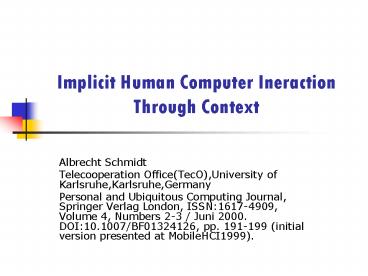Implicit Human Computer Ineraction Through Context - PowerPoint PPT Presentation
1 / 23
Title:
Implicit Human Computer Ineraction Through Context
Description:
Implicit Human Computer Ineraction Through Context Albrecht Schmidt Telecooperation Office(TecO),University of Karlsruhe,Karlsruhe,Germany Personal and Ubiquitous ... – PowerPoint PPT presentation
Number of Views:242
Avg rating:3.0/5.0
Title: Implicit Human Computer Ineraction Through Context
1
Implicit Human Computer Ineraction Through Context
- Albrecht Schmidt
- Telecooperation Office(TecO),University of
Karlsruhe,Karlsruhe,Germany - Personal and Ubiquitous Computing Journal,
Springer Verlag London, ISSN1617-4909, Volume 4,
Numbers 2-3 / Juni 2000. DOI10.1007/BF01324126,
pp. 191-199 (initial version presented at
MobileHCI1999).
2
outline
- Introduction
- Implicit Intercation
- Perception
- How Can HCI Benefit from Conext?
- Conclusion and Further Work
3
Introduction
- Looking at HCI, it is apparent that interaction
techniques are limited by the technology
available - In this paper we start with the perception of
simple concepts and with their exploitation
4
Implicit Interatcion
- Implicit vs. explicit HCI
- What is context?
- Applicatiobs in context
- Identifying implicit HCI
- Modelling implicit HCI
5
Implicit vs. explicit HCI
- The implicit interaction is based on two main
concepts?perception?interpretation - Implicit interaction will be used additionally to
explicit interaction
6
Implicit vs. explicit HCI
- The ability to have perception of the use, the
environment, and the circumstances - Mechanisms to understand what the sensors see,
hear and feel - Applications that can make use of this information
7
What is context?
- What is definition of context?
- In this paper they propose to regard situational
context, such as location or state of the device,
as implicit input to the system
8
Applications in context
- It can be observed that an application
is?running on a specific device?at a certain
time?used by one or more users?in a certain
physical environment?in a social setting?to
solve a particular task
9
Indentifying implicit HCI
- What happens around an application while the
application is in use? - Do the surroundings carry any valuable
information for the application? - Are there any means to capture and extract the
information? - How to understand the information?
10
Indentifying implicit HCI
- 1. create the set C
- 2. set D
- 3. for each Ci ? C
- define Ai. // accuracy
- define Ui. // update rate
- identify Si // a sensor device
- // that is appropriate
- if cost(Si, Ai, Ui) is acceptable then
- D D ?( Ci, Si, Ai, Ui)
- next
- 4. if D ? then
- for each vector Di in D
- define a set of application reaction Ri
(Iij, Rij) - // Iij is input range, application reaction
pairs Iij - // Rij is application reaction
- else
- // implicit interaction is not used
- //(either no condition that are useful or too
costly)
11
Indentifying implicit HCI
- 1C is the set of surrounding conditions each
Ci stands for one condiction - 3.If the cost for the identified sensing device
Di is acceptable,then the vecter describing
to the set D - 4.for each of conditions range values that are
meaningful are identified and for ranges the
reaction is defined
12
Modelling implicit HCI
- lt!ELEMENT context_interaction
- (context , action )gt
- lt!ELEMENT context (group )gt
- lt!ELEMENT group (PCDATA )gt
- lt!ATTLIST group match
- (one all none ) REQUIRED gt
- lt!ELEMENT action (PCDATA )gt
- lt!ATTLIST action
- time CDATA 0
- trigger (enter leave in )
- REQUIRED gt
Data type definition
13
Modelling implicit HCI
- ltcontext_interactiongt
- ltcontextgt
- ltgroup matchonegt
- sensor_module.touch
- pilot.on
- lt/groupgt
- ltgroup matchnonegt
- sensor_module.alone
- pilot.pen_down
- lt/groupgt
- lt/contextgt
- ltaction triggerenter time3gt
- pilot.notepad.confidential
- lt/actiongt
- lt/context_interactiongt
Context description
14
Perception
- Context awareness component
- Sensor board
- Related work on context sensing
15
Context awareness
component
- The specific contexts in this paper are based on
aural information
16
Sensor board
- They build a context recognition device equipped
with a light sensor, acceleration sensor, a
passive infrared sensor, a touch sensor, and a
temperature sensor
17
Related work on context sensing
- A cup can aware of its statee.g. warm, cold, on
table, drinking, moved - A jacket that knows if it is on the hanger or
with user is persented
18
How can HCI benefit from context
- Output in context
- Input in context
- Context notepad on a palmpilot
19
Output in context
- Adapt the output to the current situation
- Find the most suitable time interruption
- Reduce the need for interruptions
20
Input in context
- adapt the input system to the current situation
- Limit need for input
- Reduce selection space
21
Context NotePad on a PalmPilot
- On/Off
- Fontsize
- Backlight
- Privacy settings
22
Conclusion and Further Work
- The most important thing that system understands
as input - What happens around the appliction
- How can this be sensed
- How to interpret this information
23
Thank you































